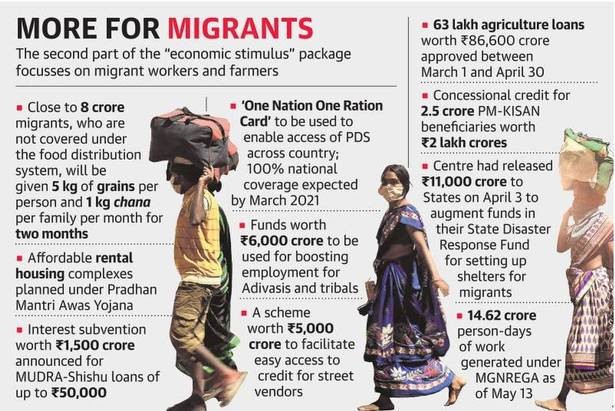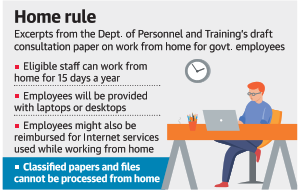15th May 2020 Current Affairs in English

15th May 2020 Current Affairs in English – Today Current affairs PDF link available below.
Dear Aspirants, we (Vetripadi.com team) have come with Daily Current affairs analysis. It is prepared to crack the various competitive exams. We are here to make sure your preparation easy. We will update the current affairs every day. It will help for both preliminary and mains (facts oriented with background information) for your preparation. We need you support.
VETRIPADI Daily Newsletter
வெற்றிப்படி.காம் | வெற்றிக்கு நீ படி!!!
Daily Current affairs for Competitive
Exams ( UPSC, TNPSC, SSC)
15th May 2020
TABLE OF CONTENTS
- Coronavirus package | Migrant workers to get free food grains
- MUDRA Scheme
- The Mahatma Gandhi National Rural Employment Guarantee Act (MGNREGA), 2005
- India reminds China of claims over GilgitBaltistan
- CBDT notifies reduction in TDS/TCS.
- Central Board of Direct Taxes
1. Coronavirus package | Migrant workers to get free food grains
Information in News
- To provide free foodgrains for the next two months to migrant workers who do not have ration cards. The Centre will spend ₹3,500 crore for this purpose.
- There are an estimated 8 crore migrant workers who have been housed in government and privately run relief camps across the country since the lockdown.
- The move to provide free foodgrain for migrant workers is an extension of the Pradhan Mantri Gharib Kalyan Yojana, which provided an additional monthly free rice or wheat allocation of 5 kg per person, and 1 kg of pulse per household from April to June to the 80 crore people with ration cards covered by the National Food Security Act (NFSA).
- The Finance Minister added that by August 2020, the ration card portability scheme will allow 67 crore NFSA beneficiaries in 23 connected states to use their cards at any ration shop anywhere in the country, allowing migrant workers to access subsidised food away from their home villages.
- The scheme would cover all beneficiaries by March 2021.
- The One Nation One Ration Card scheme was originally supposed to cover all States by June 2020.

- The Department of Personnel and Training may provide the option of work from home to eligible officers and other employees for 15 days a year as a matter of policy,
- The department asked the Ministries and departments to send in their suggestions by May 21.

1. MUDRA Scheme
- The Pradhan Mantri Mudra Yojana was introduced in April 2015 as an effort to extend affordable credit to micro and small enterprises.
- Loans up to Rs. 10 lakh are extended to these non-corporate, non-farm enterprises by the Micro Units Development and Refinance Agency (MUDRA) through last-mile financial institutions.
- So far, 15.56 crore loans worth a total of Rs. 7.23 lakh crore have been disbursed.
- In December 2017, faced with mounting criticism on the failure to create job opportunities, the Labour Ministry had asked the Labour Bureau to initiate the survey on jobs created through the MUDRA scheme.
2. The Mahatma Gandhi National Rural Employment Guarantee Act (MGNREGA), 2005
- Ministry of Rural Development has been implementing ‘The Mahatma Gandhi National Rural Employment Guarantee Act (MGNREGA), 2005’ which provides at least one hundred days of guaranteed wage employment in every financial year to every rural household whose adult members volunteer to do unskilled manual work.
- The demand for work itself is influenced by various factors such as rain-fall pattern, availability of alternative and remunerative employment opportunities outside MGNREGA and prevailing unskilled wage rates.
Increase in Days of Employment Under MGNREGA
- An additional 50 days of wage employment are provided over and above 100 days in the notified drought affected areas or natural calamity areas in the country on recommendation of the Ministry of Agriculture and Farmers Welfare.
- The Ministry also mandates the provision of additional 50 days of wage employment to every Scheduled Tribe Household in a forest area, provided that these households have no other private property except for the land rights provided under the FRA Act, 2006.
- Wage rates for workers under the Mahatma Gandhi National Rural Employment Guarantee Act (MGNREGA), 2005 are notified annually based on Consumer Price Index-Agricultural Labourers (CPI-AL) by the Central Government in accordance with the provisions of section 6(1) of the MGNREGA. The Ministry has notified wage rates for the FY 2019-20 under MGNREGA from 1st April, 2019.
2. India reminds China of claims over Gilgit Baltistan
Information in News
- India reminded China about India’s claims over Gilgit Baltistan where China has teamed up with Pakistan to build the DiamerBhasha dam.

- One of the biggest Chinese power companies, received a contract to build the DiamerBhasha dam which once completed will allow Pakistan to use the waters of the Indus for irrigation. Islamabad claims that the dam will help reduce downstream flood by the Indus.


3. CBDT notifies reduction in TDS/TCS.
Information in News
- A reduction in the rate of tax deducted at source (TDS) and tax collected at source (TCS) for non-salaried payments, the Central Board of Direct Taxes (CBDT) notified revised rates that will be applicable from May 14, 2020 to March 31, 2021.
Why the TDS rate had not been reduced for the salaried class?
- TDS was deducted from salary after considering various eligible deductions such as 80C of the salaried person.
- If we reduced the TDS rate for salaried class, then their compliance burden would have increased because they would be required to pay higher taxes at the yearend along with interest. Hence, TDS rate has not been cut for them.
- Cash withdrawal of above ₹1 crore from banks would continue to attract 1% TDS and such a transaction would not enjoy the benefit of reduced TDS rate.
- There had been no cut in the TDS rate for foreign remittances as well as where the tax is required to be deducted or collected at higher rate due to non-furnishing of PAN/Aadhaar.
- A 10% TDS was levied on interest on securities, interest on bank account, dividend payments, which has now been reduced to 7.5%.
- This is done to ensure businesses have liquidity.
The Central Board of Direct Taxes
- The Central Board of Direct Taxes is a statutory authority functioning under the Central Board of Revenue Act, 1963.
- The officials of the Board in their ex-officio capacity also function as a Division of the Ministry dealing with matters relating to levy and collection of direct taxes.
- The Central Board of Revenue as the apex body of the Department, charged with the administration of taxes, came into existence as a result of the Central Board of Revenue Act, 1924.
- Initially the Board was in charge of both direct and indirect
- However, when the administration of taxes became too unwieldy for one Board to handle, the Board was split up into two, namely the Central Board of Direct Taxes and Central Board of Excise and Customs with effect from 1.1.1964.
- This bifurcation was brought about by constitution of two Boards u/s 3 of the Central Board of Revenue Act, 1963.
Composition and Functions of CBDT
The Central Board of Direct Taxes consists of a Chairman and following six Members: –
- Chairman
- Member (Income-tax)
- Member (Legislation & Computerisation)
- Member (Personnel & Vigilance)
- Member (Investigation)
- Member (Revenue)
- Member (Audit & Judicial)
4. Prelims Point in News
- COBAS 6800, is a fully automated, high-end machine for performing real time PCR testing of COVID19. It will provide quality, high volume testing with a high throughput of test around 1200 samples in 24 hours. It will largely increase the testing capacity with reduction in pendency.
- President Ram Nath Kovind has decided to forgo 30% of his salary for the whole year apart from directing officials to adopt other austerity measures in the wake of the coronavirus (COVID19) pandemic.

